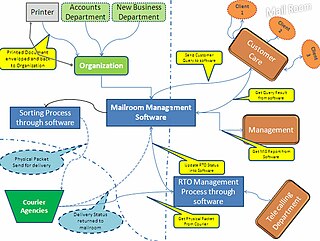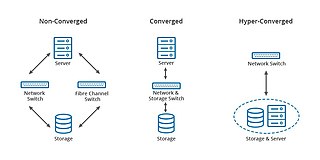Related Research Articles

Accounts payable (AP) is money owed by a business to its suppliers shown as a liability on a company's balance sheet. It is distinct from notes payable liabilities, which are debts created by formal legal instrument documents. An accounts payable department's main responsibility is to process and review transactions between the company and its suppliers and to make sure that all outstanding invoices from their suppliers are approved, processed, and paid. The accounts payable process starts with collecting supply requirements from within the organization and seeking quotes from vendors for the items required. Once the deal is negotiated, purchase orders are prepared and sent. The goods delivered are inspected upon arrival and the invoice received is routed for approvals. Processing an invoice includes recording important data from the invoice and inputting it into the company's financial, or bookkeeping, system. After this is accomplished, the invoices must go through the company's respective business process in order to be paid.
Total cost of ownership (TCO) is a financial estimate intended to help buyers and owners determine the direct and indirect costs of a product or service. It is a management accounting concept that can be used in full cost accounting or even ecological economics where it includes social costs.

A timesheet is a method for recording the amount of a worker's time spent on each job. Traditionally a sheet of paper with the data arranged in tabular format, a timesheet is now often a digital document or spreadsheet. The time cards stamped by time clocks can serve as a timesheet or provide the data to fill one. These, too, are now often digital. Timesheets came into use in the 19th century as time books. To record time in a more granular fashion, time-tracking software may be used.
Enterprise content management (ECM) extends the concept of content management by adding a timeline for each content item and, possibly, enforcing processes for its creation, approval, and distribution. Systems using ECM generally provide a secure repository for managed items, analog or digital. They also include one methods for importing content to bring manage new items, and several presentation methods to make items available for use. Although ECM content may be protected by digital rights management (DRM), it is not required. ECM is distinguished from general content management by its cognizance of the processes and procedures of the enterprise for which it is created.
Field service management (FSM) refers to the management of a company's resources employed at or en route to the property of clients, rather than on company property. Examples include locating vehicles, managing worker activity, scheduling and dispatching work, ensuring driver safety, and integrating the management of such activities with inventory, billing, accounting and other back-office systems. FSM most commonly refers to companies who need to manage installation, service, or repairs of systems or equipment. It can also refer to software and cloud-based platforms that aid in field service management.
Reimbursement is the act of compensating someone for an out-of-pocket expense by giving them an amount of money equal to what was spent.
Employee scheduling software automates the process of creating and maintaining a schedule. Automating the scheduling of employees increases productivity and allows organizations with hourly workforces to re-allocate resources to non-scheduling activities. Such software will usually track vacation time, sick time, compensation time, and alert when there are conflicts. As scheduling data is accumulated over time, it may be extracted for payroll or to analyze past activity. Although employee scheduling software may or may not make optimization decisions, it does manage and coordinate the tasks. Today's employee scheduling software often includes mobile applications. Mobile scheduling further increased scheduling productivity and eliminated inefficient scheduling steps. It may also include functionality including applicant tracking and on-boarding, time and attendance, and automatic limits on overtime. Such functionality can help organizations with issues like employee retention, compliance with labor laws, and other workforce management challenges.

On-premises software is installed and runs on computers on the premises of the person or organization using the software, rather than at a remote facility such as a server farm or cloud. On-premises software is sometimes referred to as "shrinkwrap" software, and off-premises software is commonly called "software as a service" ("SaaS") or "cloud computing".

Accounting software is a computer program that maintains account books on computers, including recording transactions and account balances. It may depends on virtual thinking. Depending on the purpose, the software can manage budgets, perform accounting tasks for multiple currencies, perform payroll and customer relationship management, and prepare financial reporting. Work to have accounting functions be implemented on computers goes back to the earliest days of electronic data processing. Over time, accounting software has revolutionized from supporting basic accounting operations to performing real-time accounting and supporting financial processing and reporting. Cloud accounting software was first introduced in 2011, and it allowed the performance of all accounting functions through the internet.
Momentem is a call, time and expense management service for smartphones.
Business process management (BPM) is the discipline in which people use various methods to discover, model, analyze, measure, improve, optimize, and automate business processes. Any combination of methods used to manage a company's business processes is BPM. Processes can be structured and repeatable or unstructured and variable. Though not required, enabling technologies are often used with BPM.
Enterprise forms automation is a company-wide computer system or set of systems for managing, distributing, completing, and processing paper-based forms, applications, surveys, contracts, and other documents. It plays a vital role in the concept of a paperless office.

Digital mailroom is the automation of incoming mail processes. Using document scanning and document capture technologies, companies can digitise incoming mail and automate the classification and distribution of mail within the organization. Both paper and electronic mail (email) can be managed through the same process allowing companies to standardize their internal mail distribution procedures and adhere to company compliance policies.
Inventory management software is a software system for tracking inventory levels, orders, sales and deliveries. It can also be used in the manufacturing industry to create a work order, bill of materials and other production-related documents. Companies use inventory management software to avoid product overstock and outages. It is a tool for organizing inventory data that before was generally stored in hard-copy form or in spreadsheets.
Wireless Expense Management (WEM) is an extension of Telecom Expense Management (TEM) services and is the process of managing enterprise's mobile and wireless devices. However, not only auditing invoices are enough to fully manage the device from procurement to retirement. Corporations need to be able to focus on their core business; the larger the business, the more there is to handle on a day-to-day basis. Businesses with a large mobile/cellular/wireless presence also have the expenses associated with them. These companies need professional Telecom Expense Management (TEM) to help them manage their wireless telecom bills accurately and effectively.

Veramark Technologies, Inc. provided services and software for Telecom Expense Management and call accounting. The company "specialized in controlling telecom expenses by managing a company's voice, data, and wireless services through a combination of auditing, consulting and software".

Converged infrastructure is a way of structuring an information technology (IT) system which groups multiple components into a single optimized computing package. Components of a converged infrastructure may include servers, data storage devices, networking equipment and software for IT infrastructure management, automation and orchestration.
Payroll automation refers to the use of computers to produce paychecks and manage benefit payments for a company or community. Often, payroll automation is integrated into the company's enterprise resource planning system that provides an overall view of the company's or community's finances; in addition to payroll, it can manage customer relationships, production, personnel resources, invoicing and accounting.
KDS is a SaaS technology provider for online business travel booking and expense management. It is also known as the Neo Technology Group (NTG) since its acquisition by American Express Global Business Travel (GBT). Yves Weisselberger founded the company in 1994 and served as its CEO until 2011. Dean Forbes took the position of CEO after Weisselberger. The company is based in Issy-les-Moulineaux, France with additional locations in Germany, United Kingdom, and the United States of America.
A treasury management system (TMS) is a software application which automates the process of managing a company's financial operations. It helps companies to manage their financial activities, such as cash flow, assets and investments, automatically. A TMS is commonly used to maintain financial security and minimize reputational risk. It can be used by a company's internal management, and may be purchased from a technical supplier.
References
- ↑ "Removed".
- ↑ "Best-In-Class T&E Expense Management: How They Do It,"
- ↑ Basso, Luiz Augusto Carvalho & Claudio (2014-01-01). Telecom Expense Management for Large Organizations. iUniverse. ISBN 9781491720028.
- ↑ Enoch, Marcus (2016-04-01). Sustainable Transport, Mobility Management and Travel Plans. Routledge. ISBN 9781317047650.